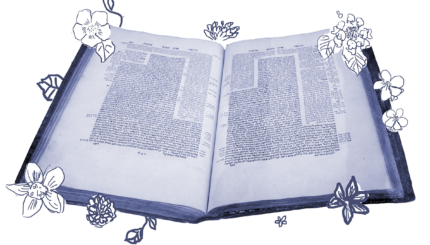First, a quick lesson in Temple geography: As one entered the Temple, one would progress through zones of increasing holiness. The outer courtyard was available to women and, consequently, called the women’s courtyard. The next area, the Israelites’ courtyard, contained an enormous altar, called the outer or external altar, on which most sacrifices were offered. Beyond that courtyard, there was then an enclosed sanctuary that contained a second altar, known as the inner altar, which was smaller and used for a handful of exclusive sacrifices. Moving through this sanctuary, one would eventually reach the back of the Temple which contained the Holy of Holies, hidden behind a curtain.
A mishnah back on 36b noted that, according to Beit Hillel, for all offerings on the external altar, if the priest places blood on one corner, even if the blood was supposed to be placed on two or four corners, the offering is effective. However, a higher standard is applied to sacrifices bound for the inner altar:
All the offerings whose blood is to be placed on the inner altar, if the priest omitted even one of the placements, it is as though he did not facilitate atonement.
The offerings whose blood was placed on the inner altar were as follows: the bull and goat of Yom Kippur, the bull for an unwitting sin of the high priest, the bull for an unwitting sin of the congregation and the goat for an unwitting communal sin of idol worship. For these offerings, placement of blood on each and every corner was indispensable. Missing even one corner invalidated the sacrifice.
On today’s daf, a beraita attempts to lay out how we derive some of these rules. In Leviticus 4, the Torah first lays out the details of how the high priest must sacrifice a bull when he sins. It then describes the sacrifice of a bull for a communal sin which, it turns out, has an identical sacrificial process. The Torah details the necessary steps, and then declares that the priest “shall do with the bull (for the communal sin) as he did with the bull for a sin offering (of the high priest).” (Leviticus 4:20)
The sages taught: This phrase: “And he shall do … as he did” — what does this come to teach?
This phrase is, at first glance, extraneous. The Torah just explicitly detailed the procedure of the communal sin offering, even though it’s identical to that of the high priest’s sin offering. Why, then, must it follow this up by stating that the priest treats these offerings identically? The beraita answers:
The verse comes to repeat the halakhah of the sprinkling of the blood, thereby teaching that if the priest omitted one of the placements he has done nothing.
The sages suggest that this seemingly unnecessary repetition teaches us an additional rule about the bull for a communal sin — that if even one corner is missed, the sacrifice is invalidated. The beraita continues to derive our other cases from this verse:
“And he shall do with the bull” (Leviticus 4:20) — this alludes to the bull of Yom Kippur. “As he did with the bull” (Leviticus 4:20) — this is a reference to the bull for an unwitting sin of the anointed priest. “A sin offering” — these are the goats for an unwitting communal sin of idol worship. One might have thought that I should include also the goats of the festivals and the goats sacrificed on the new moons; therefore, the verse states: “So shall he do with this.” (Leviticus 4:20)
The beraita now draws meaning from each phrase of this seemingly extraneous verse. “So shall he do” teaches that the inner altar blood placements for the communal sin offering of a bull are indispensable. The phrase “with the bull” comes to include another bull offering, namely that of Yom Kippur. “As he did with the bull,” alludes to the previous case of the high priest’s sin offering, teaching that there too all blood placements are indispensable. It didn’t need to add that the previous bull was a sin offering, since the text has already stated as much; therefore, the phrase “the bull for a sin offering” comes to include the other instance of a communal sin offering, where in the case of idolatry, they sacrifice a goat. When the sin offering of a goat for unwitting communal idolatry is mentioned elsewhere, the procedure of its offering is not detailed. Therefore, we learn from this extraneous phrase that its procedure is identical to the bulls listed above.
There are two other cases of goats sacrificed as communal offerings: those sacrificed on festivals and on new moons. I might have thought that just as the goat offered for a communal sin of idolatry is sacrificed in the inner sanctuary, with these particular indispensable blood placements, so too should we offer these other goats that way. Therefore, when the verse states “so shall he do with/for this,” implying a restriction: only one additional offering (the sin offering of the goat) can be learned out from this verse, but no further cases. This one verse has proved incredibly rich for halakhic exegesis, but the beraita maintains that there are limits to how many cases can be learned from it.
Read all of Zevachim 39 on Sefaria.
This piece originally appeared in a My Jewish Learning Daf Yomi email newsletter sent on October 23, 2025. If you are interested in receiving the newsletter, sign up here.
With your help, My Jewish Learning can provide endless opportunities for learning, connection and discovery.



